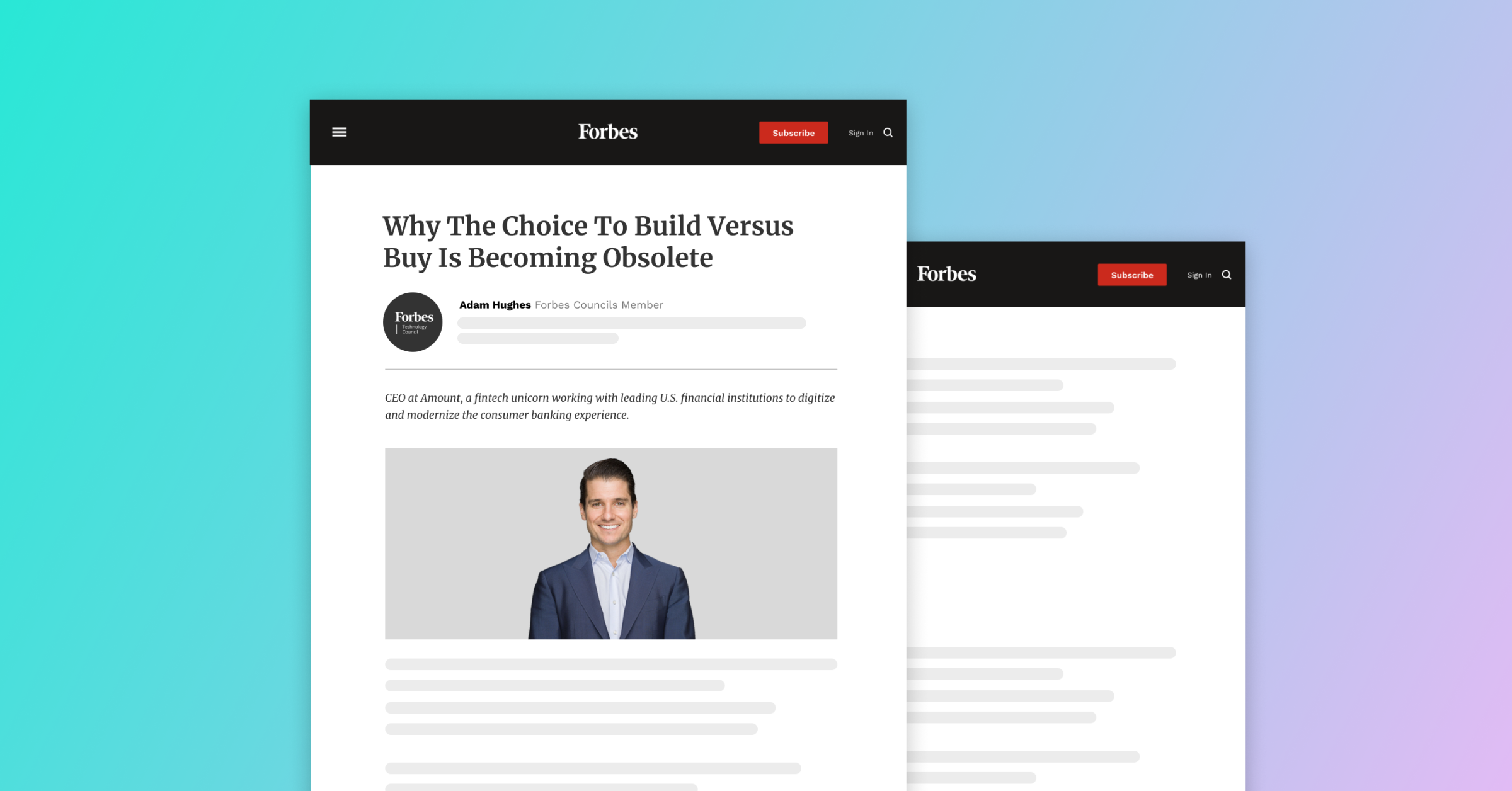
This is a reprint of a byline that originally ran on Forbes.com on November 15, 2021.
When it comes to modern-day banking, just about every organization is powered by digital applications. Banks are operating in a new world in which application program interfaces (APIs) have become a common boardroom topic and non-bank financial players have become a common threat. Going to market with competitive digital bank offerings is an endless cycle of playing catch-up, requiring banks to understand that yesterday is the new tomorrow, even if those solutions are built to today’s requirements.
This is why the decision whether to build vs. buy is becoming obsolete.
For starters, the traditional concept of build vs. buy assumes a binary decision. And it’s not. Banking innovation isn’t about strictly building or strictly buying, it’s about meeting somewhere in between. Banks have already invested heavily in internal resources and systems, and there is no need to completely overhaul existing infrastructure in most cases. By pivoting away from the build vs. buy mindset and embracing strategic partnerships that fill technology gaps and rapidly digitize processes, banks can accelerate speed-to-market with differentiated, customer-centric solutions.
Of course, building internally is doable, given that every bank has an Information Technology (IT) department that operates in lockstep with risk and compliance. Yet IT is primarily tasked with the governance of an organization’s network and operating systems, enabling internal communication and automating routine tasks--not innovating new customer offerings. In fact, according to a 2021 banking survey by McKinsey, up to 70% of a bank’s technology spend is allocated toward run-the-bank priorities, and only 25% to 40% of the employees assigned to business priorities are engineers, of which two-third fall into the novice or advanced-beginner category—and only 10% are experts. Thus, it’s rare that a bank’s internal resources have the technological prowess to implement new digital banking offerings.
Moreover, even if a bank is equipped with the right technological expertise to innovate and implement new customer solutions, it still struggles to get to market quickly…or at least in time to compete before the next trend hits. Take, for example, today’s much-buzzed-about financial trend: Buy Now, Pay Later (BNPL).
There’s no doubt that a bank can build out a BNPL offering. But out of the box, it’s going to take longer. Aside from the actual build itself, it will most likely take a year just to weed through the bureaucracy, backlog, conflicting business goals and budgeting.
Then there’s the question of what type of BNPL offering the bank is building, a particularly complex consideration given the numerous options around payment types, vehicles, channels and integration methods. If internal teams start building out a split pay, what happens if the business group wants to pivot and offer installments instead? This is not simply a matter of shifting gears – it requires a completely new build.
Perhaps most critically, however, is that while banks have rolled out new products, they have never rolled out BNPL. Banks don’t know the intricacies of connecting with a merchant’s systems; integrating into ecommerce and, potentially, in-store; managing orders and returns; or creating a user interface that checks for fraud.
As a result, by the time a bank’s internal teams are able to push out a BNPL offering that checks all the boxes, odds are it will no longer be relevant. Even more, once the product requires the inevitable software update, it may take a year or two to get this on IT’s to-do list.
Equally outdated is the back half of the build vs. buy conundrum. At this point on the banking innovation spectrum, most banks have already made significant technology investments. An organization that already has a preferred decision engine, risk model or identity and fraud verification system in play should look for a technology partner to bolster these capabilities and fill in the gaps, not replace them. After all, why buy an end-to-end solution when you already have a third of it built?
Yet while it’s clear that fintechs excel at developing new digital offerings efficiently, what’s not so clear is what technology partner may be the best fit for an organization. To that end, there are a few key considerations to ensure a successful partnership.
Given the urgency in digitizing banking services and the learning curve required to do so (especially with an offering like BNPL), banks will likely need a technology partner to do more of the heavy lifting up front, at least to get into market quickly and securely on Day One. Therefore, it’s critical that the technology partnership be flexible and modular to allow the bank to evolve its digital offerings as the market matures. Because by Day Two, when the new digital offering has become part of the bank’s DNA, the bank should be able add in its own features and subtract ones that provide little value. This empowers a bank to continue to iterate and improve its offering without the time and expense of rebuilding or buying, or even scrap it if it gets deprioritized.
And just as important as the technology, is the support. Working with a partner that acts as a trusted advisor, that’s truly committed to understanding a bank’s digital readiness and developing differentiated go-to-market strategies that meet the unique needs of a bank’s customers -- not just what’s hot in the marketplace -- is pivotal. This enables a bank to genuinely and seamlessly revolutionize the way its customers spend, save and borrow, from simplifying personal loan originations to streamlining credit card applications to offering omnichannel point-of-sale options to…whatever comes next.
While BNPL is topping headlines today, you can bet a new competitive offering will be trending next year, if not sooner. With convenient, friction-free digitally enabled consumer experiences now the expectation, not the exception, an ever-emerging roster of competitors is seeking to capitalize where banks fall short, irrevocably changing the banking playing field. Banks can no longer afford to look backward, which means they need to change their all-or-nothing mindset and accept that to future-proof their business, they need a partner for success.

Learn how Amount is leveraging strategic partnerships to help our customers better compete in the BNPL space.
 Watch Video
Watch Video